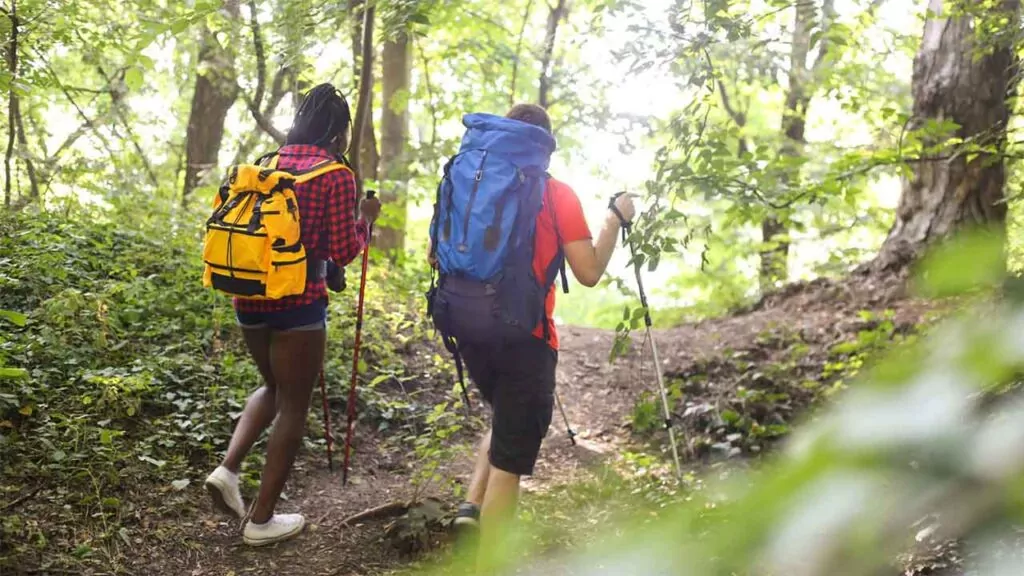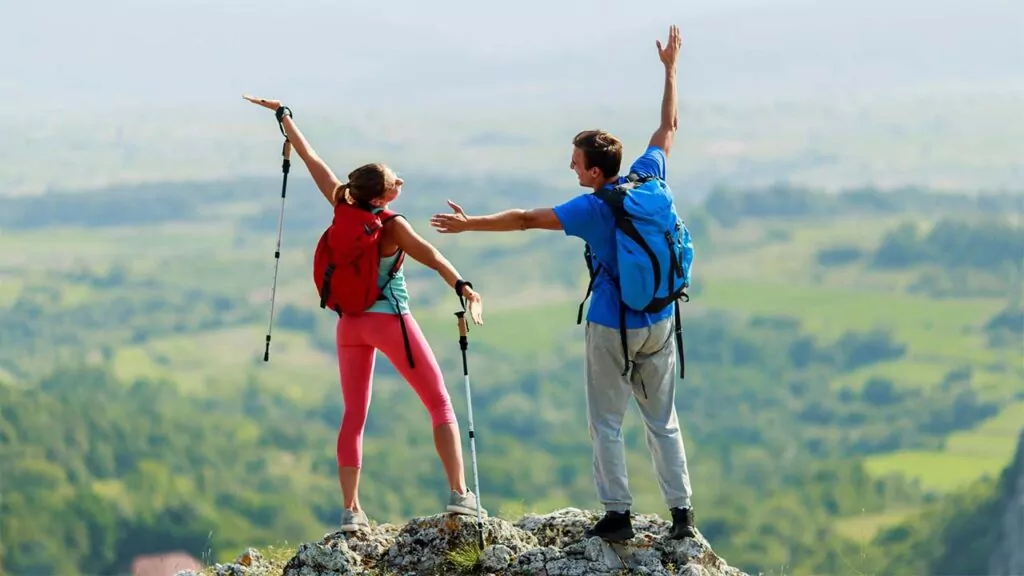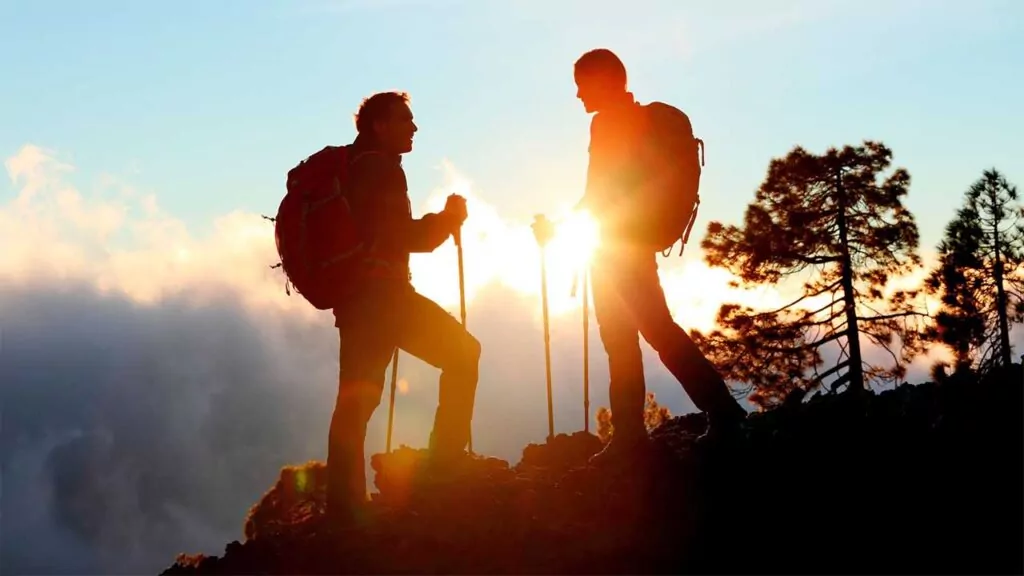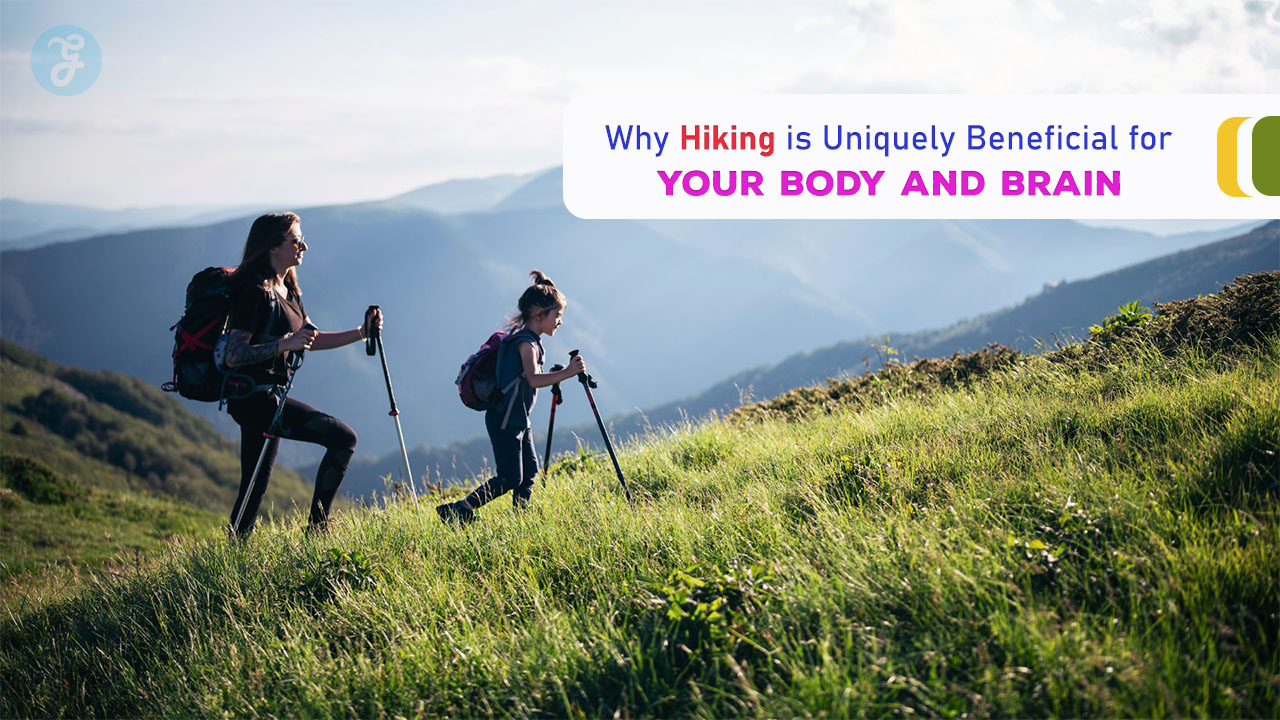Picture yourself standing at the edge of a forest trail. The air is crisp and clean, filled with the scent of pine and earth. Sunlight filters through the leaves, creating a dappled pattern on the ground before you. After taking your first steps on the path, you’re starting a journey that will benefit your entire being in unexpected ways.
Hiking has surged in popularity in recent years, with more people discovering the joys of exploring nature on foot. In 2020 alone, despite global challenges, the Outdoor Foundation reported that 57.8 million Americans hit the trails, marking a significant increase from previous years. But hiking is more than just a trendy pastime or a way to get some exercise. It’s a uniquely powerful activity that offers a wealth of benefits for both your body and your brain.
Unlike many other forms of exercise, hiking combines physical activity with exposure to nature, creating a synergistic effect that amplifies its positive impact. From boosting cardiovascular health to enhancing cognitive function, from reducing stress to fostering social connections, hiking stands out as a holistic approach to well-being. In this article, we’ll explore the many ways that lacing up your boots and hitting the trail can transform your health, happiness, and overall quality of life.
Physical Benefits of Hiking

Let’s start our journey by examining the remarkable physical benefits that hiking offers. While many forms of exercise can improve your physical health, hiking provides a unique combination of advantages that sets it apart from gym workouts or urban jogging.
Read More: Essential Packing Tips for Travelers
Cardiovascular Health
Hiking is an excellent cardiovascular exercise. As you traverse varying terrains, your heart rate increases, pumping more oxygen-rich blood throughout your body. This aerobic activity strengthens your heart, reduces the risk of heart disease, lowers blood pressure, and improves overall circulation.
Regular hiking reduces the risk of cardiovascular disease by:
- Lowering blood pressure by 4-10 mm Hg
- Reducing bad cholesterol (LDL) levels by 4-7%
- Increasing good cholesterol (HDL) levels by 3-5%
Furthermore, the natural terrain variations during a hike provide interval-like training. Climbing uphill pushes your heart to work harder, while descending allows for active recovery. This natural interval training is particularly effective at improving cardiovascular fitness.
Muscular Strength and endurance
Hiking engages multiple muscle groups simultaneously, offering a full-body workout. Here’s how different muscle groups benefit:
- Legs: Your quadriceps, hamstrings, and calves get a thorough workout, especially when climbing inclines.
- Core: Balancing on uneven terrain engages your abdominal and back muscles.
- Arms and shoulders: Using trekking poles or climbing over obstacles works your upper body.
- Glutes: Uphill sections particularly target your gluteal muscles.
Unlike repetitive gym exercises, hiking constantly changes the demands on your muscles, promoting balanced strength development and improved muscular endurance.
Weight Management
Hiking is an effective way to manage weight. The number of calories burned while hiking varies based on factors like body weight, pack weight, terrain, and pace. However, on average, a 154-pound person can burn:
- 370 calories per hour hiking on flat terrain
- 460 calories per hour hiking uphill
What makes hiking particularly effective for weight management is its low intensity, long-duration nature. This type of exercise is ideal for burning fat while preserving muscle mass.
Bone Density Improvement
Hiking is a weightbearing exercise that helps maintain and even improve bone density. This is crucial for preventing osteoporosis, especially in older adults. Each step’s impact stimulates bone formation and strengthens the bones in your legs, hips, and lower spine.
A study in the American Journal of Human Biology found that regular hill walking can increase bone density in the femur by 1.5% per year, significantly reducing the risk of fractures.
Balance and Coordination
Navigating uneven terrain, stepping over roots, and crossing streams all require you to improve your balance and coordination. This has several benefits:
- Reduced risk of falls is especially important for older adults.
- Improved proprioception (your body’s ability to sense its position in space)
- Enhanced overall agility and body awareness
These physical benefits make hiking not just an enjoyable outdoor activity but a powerful tool for overall health and fitness. In the next section, we’ll explore how hiking can be equally beneficial for your mental health.
Mental Health Benefits of Hiking

While the physical benefits of hiking are impressive, the impact on mental health is equally profound. The combination of physical activity, exposure to nature, and often, social interaction creates a powerful cocktail for improved mental well-being.
Stress Reduction
One of the most immediate and noticeable benefits of hiking is stress reduction. Studies have shown that walking in nature lowers cortisol levels, the hormone associated with stress. A study published in the Proceedings of the National Academy of Sciences found that participants who walked for 90 minutes in a natural setting reported lower levels of rumination and showed reduced neural activity in an area of the brain linked to risk for mental illness compared to those who walked in an urban setting.
The reasons for this stress-reducing effect are multifaceted:
- Physical activity releases endorphins, which are natural mood elevators.
- Exposure to nature activates the parasympathetic nervous system, promoting relaxation.
- The rhythmic nature of walking can induce a meditative state.
- Natural settings often have lower levels of sensory input, giving our often-overstimulated brains a chance to rest and recover.
Mood Improvement
Hiking isn’t just about reducing negative emotions; it’s also about boosting positive ones. Regular hikers often report feelings of joy, peace, and contentment during and after their treks. Several factors contribute to this mood-boosting effect.
- Increased vitamin D exposure from sunlight plays a role in regulating mood.
- Serotonin and norepinephrine, neurotransmitters that aid in mood regulation, are released.
- I feel a sense of accomplishment after finishing a hike.
- Being in beautiful natural surroundings provides an aesthetic pleasure.
Anxiety and Depression Management
For those dealing with anxiety or depression, hiking can be a valuable tool in their mental health toolkit. PLOS One published a 2018 study that linked group nature walks to significantly lower depression, reduced perceived stress, and improved mental well-being.
The reasons hiking can be beneficial for anxiety and depression include:
- Distraction from negative thought patterns.
- Increased physical activity is known to have antidepressant effects.
- Exposure to natural light can help regulate sleep patterns, which are often disrupted in depression.
- Hiking with others provides opportunities for social interaction.
Self-Esteem Boost
Hiking can significantly boost self-esteem and self-image. As you challenge yourself to complete longer or more difficult trails, you build confidence in your physical abilities. This sense of accomplishment often translates to other areas of life.
A study in the International Journal of Environmental Health Research found that as little as five minutes of exercise in a natural setting led to improvements in self-esteem, with the presence of water amplifying this effect.
Mindfulness and Present Moment Awareness
Hiking naturally encourages mindfulness—the practice of being fully present in the moment. When you’re on a trail, you’re naturally inclined to pay attention to your surroundings, your breath, and your body’s movements. Research has linked this state of mindfulness to reduced anxiety, improved mood, and better overall mental health.
The act of hiking often involves:
- As you exert yourself, pay attention to your breath.
- It’s important to pay attention to the placement of your feet on uneven terrain.
- It’s important to notice the details of nature around you—the sounds, smells, and sights.
- Avoiding digital distractions can help us stay in the present moment.
Cognitive Benefits
Beyond the realm of physical and mental health, hiking also offers significant cognitive benefits. The combination of physical exercise, exposure to nature, and navigational challenges creates an environment that stimulates and enhances brain function in various ways.
Improved Attention and Focus
Our digital age increasingly challenges our ability to sustain attention. Hiking can serve as an antidote to the constant distractions of modern life. Participants on a nature walk outperformed those walking in an urban environment on attention-demanding tasks, according to a PLOS One study.
This improvement in attention and focus can be attributed to several factors:
- Reduced exposure to attention-demanding stimuli found in urban environments.
- You must concentrate on your immediate surroundings for safety and navigation.
- Nature has a restorative effect on cognitive resources.
Enhanced Creativity
Many influential thinkers throughout history, from Beethoven to Darwin, have credited nature walks with boosting their creativity. Modern research supports this anecdotal evidence. A study in the Journal of Experimental Psychology found that participants showed a 50% improvement in creative problem-solving tasks after immersing themselves in nature for four days.
Hiking stimulates creativity by:
- It fosters divergent thinking by allowing the mind to roam freely.
- Natural surroundings provide novel stimuli that can spark new ideas.
- Reducing stress and mental fatigue, which can hinder creative thought, is crucial.
Better Problem-Solving Skills
The varied and sometimes challenging nature of hiking can improve problem-solving skills. Whether it’s finding the best path across a stream or deciding how to pace yourself for a long ascent, hiking constantly presents small problems to solve.
Participants in a Psychological Science study who spent four days in nature and away from technology performed 50% better on creative problem-solving tasks.
Memory Improvement
Regular hiking has been linked to improvements in both short- and long-term memory. A study in the Proceedings of the National Academy of Sciences found that adults who walked for 40 minutes three times a week for a year had a 2% increase in the size of their hippocampus, the brain region crucial for memory formation.
This memory enhancement can be attributed to:
- Exercise increases blood flow to the brain.
- As you navigate and remember trails, new neural connections form.
- This leads to reduced stress and improved sleep, both of which are crucial for memory consolidation.
Neuroplasticity and Brain Health
Hiking, especially in varied and challenging terrain, promotes neuroplasticity—the brain’s ability to form new neural connections. This is crucial for maintaining cognitive health as we age and can potentially reduce the risk of neurodegenerative diseases.
Regular aerobic exercise, like hiking, can boost the volume of gray matter in the brain, especially in areas linked to memory, spatial navigation, and executive functions, according to a Frontiers in Human Neuroscience study.
These cognitive benefits make hiking not just a form of exercise but a powerful tool for maintaining and enhancing brain function throughout life. In the next section, we’ll explore the social benefits of hiking, another crucial aspect of its holistic impact on well-being.
Social Benefits of Hiking

While hiking can be a solitary activity, it also offers numerous opportunities for social interaction and connection. These social aspects contribute significantly to the overall benefits of hiking.
Read Also: How Long Does It Take to Walk 11 Miles?
Bonding Opportunities
Hiking with friends, family, or a group provides an excellent opportunity for bonding. The shared experience of navigating a trail, overcoming challenges, and enjoying nature together can strengthen relationships. The Journal of Leisure Research published a study that revealed enhanced family cohesion and improved communication among families who engaged in outdoor activities together.
Key bonding elements of group hiking include:
- Shared goals and achievements
- Mutual support and encouragement
- Extended periods of uninterrupted conversation
- Creating shared memories
Community Building
Joining hiking groups or clubs can help build a sense of community. These groups often bring together people from diverse backgrounds who share a common interest. The American Hiking Society reports that there are over 1,500 trail organizations in the United States, providing ample opportunities for community engagement.
Benefits of hiking communities include:
- Regular social interaction
- Opportunities to meet like-minded individuals
- We shared knowledge about trails and hiking techniques.
- Group activities, such as conservation efforts, extend beyond hiking.
Family Time Enhancement
For families, hiking can be a valuable way to spend quality time together away from screens and daily distractions. It provides an opportunity for parents to teach children about nature, physical fitness, and perseverance.
According to a survey conducted by the Outdoor Foundation, 13% of parents identified hiking as their preferred outdoor activity with their children, citing various benefits.
- Improved family communication
- Shared learning experiences
- Children’s confidence and independence develop.
- Creation of lasting family traditions
Cultural and Historical Learning
Many hiking trails pass through areas of cultural or historical significance. This turns a hike into an educational experience, allowing hikers to learn about local history, geology, and ecology.
For example:
- The Appalachian Trail passes numerous historical sites from the American Civil War.
- Hiking in national parks often includes educational programs about local flora, fauna, and geology.
- Many European long-distance trails connect historical pilgrimage routes.
Environmental Benefits
Hiking not only benefits the individual but also fosters a deeper connection with the environment, leading to increased awareness and conservation efforts.
Connection with Nature
Regular exposure to nature through hiking can lead to a phenomenon known as “nature connectedness”—a deep sense of belonging to the natural world. A study in the Journal of Environmental Psychology found that people with a strong connection to nature were more likely to engage in environmentally friendly behaviors.
Benefits of nature connectedness include:
- Increased empathy towards non-human life
- Greater appreciation for natural beauty
- Reduced materialistic values
- Improved overall health
Environmental Awareness
Hiking provides first-hand exposure to various ecosystems and their challenges. This direct experience often leads to increased environmental awareness. Hikers are more likely to notice changes in their environment.
- The impacts of climate change on the local flora and fauna are significant.
- Pollution’s impact on natural areas.
- The consequences of overuse or misuse of trails are significant.
Conservation Motivation
As hikers develop a connection with nature and become more aware of environmental issues, they often become motivated to engage in conservation efforts. The National Park Service reports that volunteers contribute over 5 million hours annually to conservation efforts, many of whom are regular hikers.
Conservation activities often undertaken by hikers include:
- Trail maintenance and clean up
- Engagement in citizen science projects
- Advocacy for environmental protection policies
- Financial support for conservation organizations
The unique aspects of hiking set it apart from other forms of exercise.
While many forms of exercise offer health benefits, hiking has several unique characteristics that set it apart.
Varied Terrain and Natural Obstacles
Unlike running on a treadmill or cycling on a stationary bike, hiking involves navigating varied and often unpredictable terrain. This variability offers several advantages:
- Engages more muscle groups: Uneven surfaces necessitate constant adjustments, activating stabilizing muscles.
- Enhances proprioception: This improves the body’s capacity to perceive its position in space.
- Provides natural interval training: Alternating between inclines, declines, and flat areas naturally varies exercise intensity.
A study in the Journal of Experimental Biology found that walking on uneven terrain requires 28% more energy than walking on flat ground, increasing the overall workout effectiveness.
Exposure to Nature and Fresh Air
Hiking typically takes place in natural settings, exposing oneself to fresh air and nature. This exposure offers unique benefits:
- Improved air quality: Forest air contains phytoncides, natural compounds that can boost immune function.
- Increased oxygen intake: Natural settings often have higher oxygen levels than urban areas.
- Reduced exposure to urban pollutants: Time away from city air can give the respiratory system a break.
Forest environments, compared to city environments, promote lower concentrations of cortisol, a lower pulse rate, lower blood pressure, greater parasympathetic nerve activity, and lower sympathetic nerve activity.
Low-impact, accessible exercise
You can adapt hiking, a low-impact exercise, to various fitness levels. This adaptability makes hiking accessible to a wide range of people, including
- Older adults: The low-impact nature of hiking is easier on joints than running.
- Beginners: You can choose trails according to their level of difficulty.
- People with certain health conditions: The adjustable pace allows for customization.
The Centers for Disease Control and Prevention recommends hiking as a safe, effective form of exercise for people of all ages.
Cost-Effectiveness
Compared to gym memberships or expensive exercise equipment, hiking is a relatively low-cost activity. Basic equipment needs are minimal, and many trails are free to access.
The Outdoor Foundation reports that the average annual spending on hiking gear is significantly lower than many other outdoor activities, making it an economically accessible form of exercise.
Getting Started with Hiking
If you’re inspired to reap the many benefits of hiking, here’s a guide to help you get started safely and enjoyably.
Essential Gear
While hiking doesn’t require as much equipment as some outdoor activities, having the right gear can significantly enhance your experience and safety. Here’s a list of essential items:
- Hiking boots or shoes: Proper footwear provides support and traction. Choose based on the terrain you’ll be hiking.
- Backpack: A comfortable daypack to carry water, snacks, and other essentials.
- Water bottle or hydration system: Stay hydrated with at least 1 liter of water for every 2 hours of hiking.
- Weather-appropriate clothing: Dress in layers and choose moisture-wicking fabrics.
- Navigation tools include a map, compass, or GPS device, and it’s important to know how to use them effectively.
- First-aid kit: Include basics like bandages, antiseptic wipes, and any personal medications.
- Sun protection: sunscreen, sunglasses, and a hat.
- Emergency shelter: A light tarp or emergency blanket for unexpected weather.
The American Hiking Society recommends these “Ten Essentials” for every hike, regardless of duration or difficulty.
Safety Tips
Hiking safely involves preparation and awareness. Follow these guidelines to ensure a safe experience:
- Tell someone your plans: Tell a friend or family member about your route and expected return time.
- Check weather conditions: Be prepared for potential weather changes.
- Stay on marked trails: This helps preserve nature and prevents you from getting lost.
- Hike with a buddy, especially when starting out or tackling more challenging trails.
- Know your limits: Start with easier trails and gradually increase difficulty.
- Be wildlife aware: Learn about local wildlife and how to respond to encounters.
- Leave No Trace: Follow principles to minimize your impact on nature.
A study in the Wilderness & Environmental Medicine journal found that most hiking injuries and fatalities could be prevented with proper preparation and adherence to safety guidelines.
Finding Trails
With thousands of hiking trails available, finding the right one for you is key to an enjoyable experience. Here are some resources to help you discover trails:
- National and State Park websites: Offer detailed trail information and difficulty ratings.
- Hiking apps: Apps like AllTrails or Hiking Project provide user reviews and GPS maps.
- Local hiking clubs: often have group hikes for beginners and can provide local knowledge.
- Visitor centers: Staff can provide up-to-date trail conditions and recommendations.
The National Park Service reported over 327 million recreation visits in 2019, indicating the wealth of hiking opportunities available in the U.S. alone.
Building Endurance
If you’re new to hiking or returning after a break, it’s important to build your endurance gradually.
- Start with shorter, flatter hikes: Aim for 1-2 miles on relatively even terrain.
- Increase distance gradually: Add about 10% to your distance each week.
- Incorporate elevation: Once comfortable with distance, start adding hills.
- Cross-train: Supplement hiking with other cardiovascular exercises like cycling or swimming.
- Listen to your body. Rest when needed and avoid overexertion.
A study in the Journal of Applied Physiology found that consistent, gradual increases in exercise duration and intensity led to the most sustainable fitness improvements.
Conclusion
As we’ve explored throughout this article, hiking offers a unique and powerful combination of benefits for both body and brain. From improving cardiovascular health and muscular strength to reducing stress and enhancing cognitive function, the positive impacts of regular hiking are far-reaching and well documented.
The physical challenges of traversing varied terrain provide a full-body workout that’s difficult to replicate in a gym setting. Meanwhile, the exposure to nature and fresh air offers mental health benefits that extend far beyond the immediate mood boost of exercise. The cognitive benefits, including improved attention, creativity, and problem-solving skills, make hiking a valuable activity for people of all ages and professions.
So, lace up your boots, grab a water bottle, and find a trail near you. Whether it’s a short walk in a local park or a challenging mountain trek, every step you take is a step towards better physical health, mental well-being, and a deeper connection with the world around you. The path to a healthier, happier you might just be the hiking trail waiting around the corner.
Remember, the journey of a thousand miles begins with a single step. Your hiking adventure—and all the benefits it brings—starts today.





























